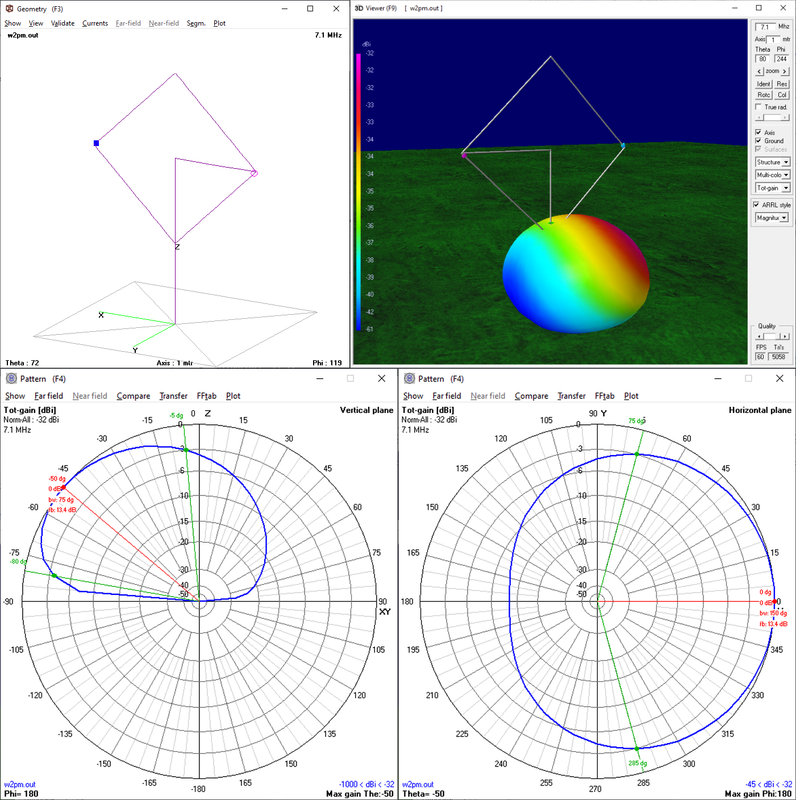4nradio wrote: ↑Mon Aug 22, 2022 9:37 pm
Hi Andrew & 13dka,
I can't thank you enough for your detailed instructions, NEC modeling results, and observations on this antenna! You've put a lot of effort into documentation and I hope a lot of radio hobbyists give this project a try.
I've used Flags and other terminated loops for years during DXpeditions for SW and MW at the Washington and Oregon coasts, with great results. I've tried Flags a couple of times at home too, but have struggled with noise pickup here.
I'm sure I'll try building the SULA, and will experiment with it on a antenna rotor at home before trekking out on a DXpedition.
Hi there, Guy, welcome aboard and thanks for your kind words, and yes, we too hope that some people will decide to give the SULA a try and possibly report their experience since such a thing could help improving this small rx antenna, and given your experience with such antennas, if you'll go on and give the SULA a spin, your feedback will be really valuable; just a note, a rotor is ok, but please use a non conductive mast/pole for the SULA since a metal one will influence the pattern, if forced to use a metal pole try keeping it at least 1m (about the length of the "diamond" diagonal) below the antenna bottom corner to reduce such influence (in this case the vertical support for the loop should be prolonged to give the needed spacing)
I have a couple of questions though:
1. I might try using a Wellbrook FLG100LN module as an amp, and this unit has a recommended termination of 900-1100 ohms. Since the SULA is designed for 530 ohms, do you think it would work OK if I added a 2:1 turns ratio transformer to the Wellbrook's loop input terminals to step down the value? (i.e., halve the requirement from 900-1100 to 450-550 ohms. I would then use the specified 530 resistance).
If this isn't feasible I will try a 50 ohms preamp following a 9:1 transformer, per the SULA design. I have some high efficiency MNX binocular cores recommended years ago by John DeVoldere ON4UN, who authored the classic "Low Band DXing" books.
2. Would a larger loop for the SULA potentially increase gain on the lower end of medium wave?
Let me start by saying that due to personal issues I can't run field tests at the moment, so my replies below are based on some NEC simulations, I hope that Ollie (13dka) will chime in and report his field data, all I can say is that till now, the results of NEC modeling the SULA reflected what Ollie observed during field tests, so I'm confident that what follows reflects the antenna behavior
Let's start from the FLG100N, that preamp has an embedded 16:1 impedance transformer at its input, so it claims for a higher resistor value to match the impedance, now, the image below shows what happens when we change the SULA resistor from 530 Ohm to 1 KOhm (I also tried 900 but the result won't change)
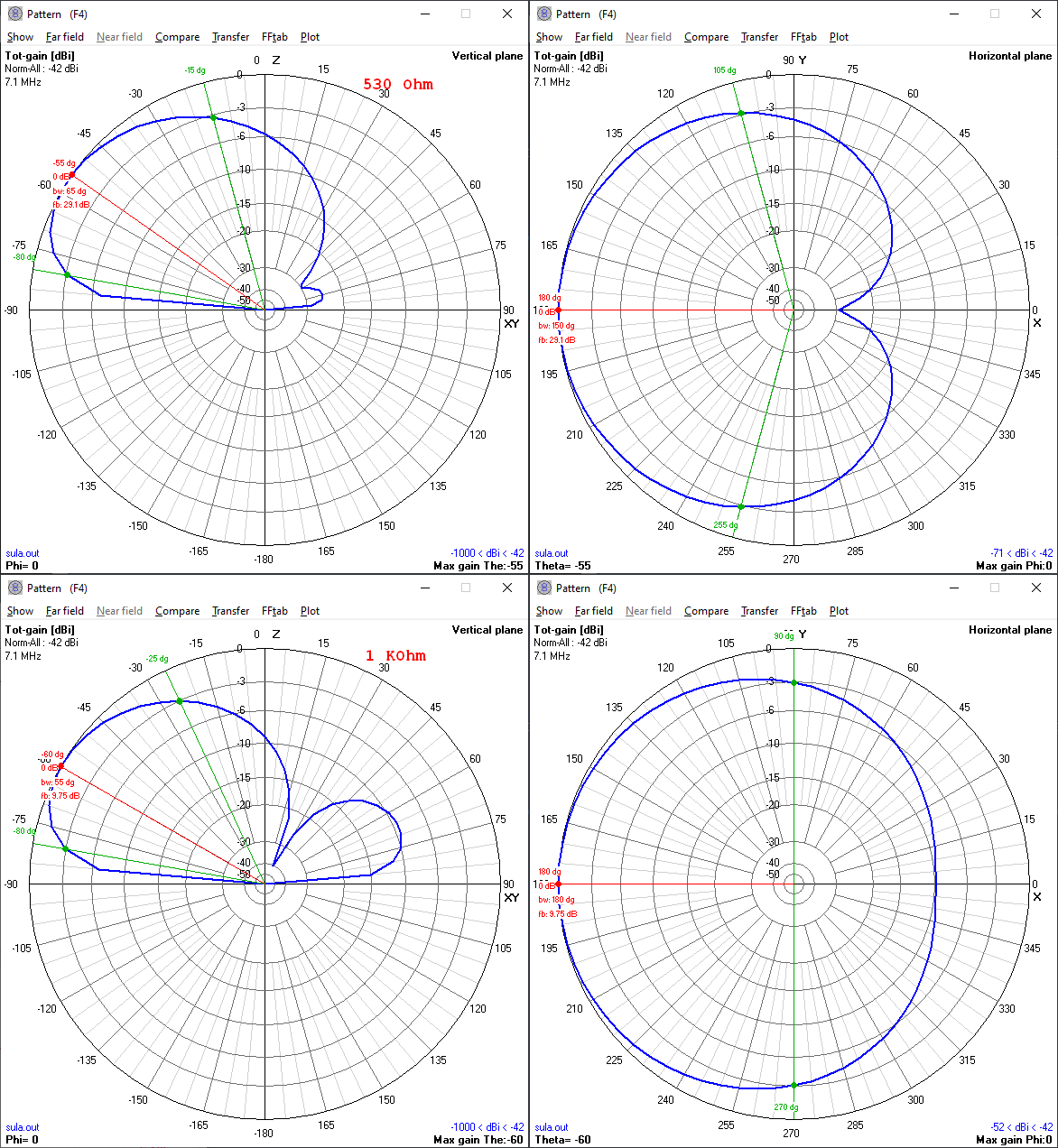
- sula_res.png (189.13 KiB) Viewed 37508 times
as you can see, the antenna pattern changes, the nice backside "null" disappears and the horizontal lobe widens to 180° so, sincerely I'd avoid such an approach; also, placing a 2:1 (ok 1:2 if we're going to raise the impedance) between the loop and the FLG100N preamp would mean having two transformers in series (our one and the one embedded inside the preamp) and, sincerely, I'm not sure about the effects such a thing could have (although I've some "suspects" and sincerely I don't think the setup will work well), that being said, you asked about size, now, let me start by showing you what happens when we change the SULA size
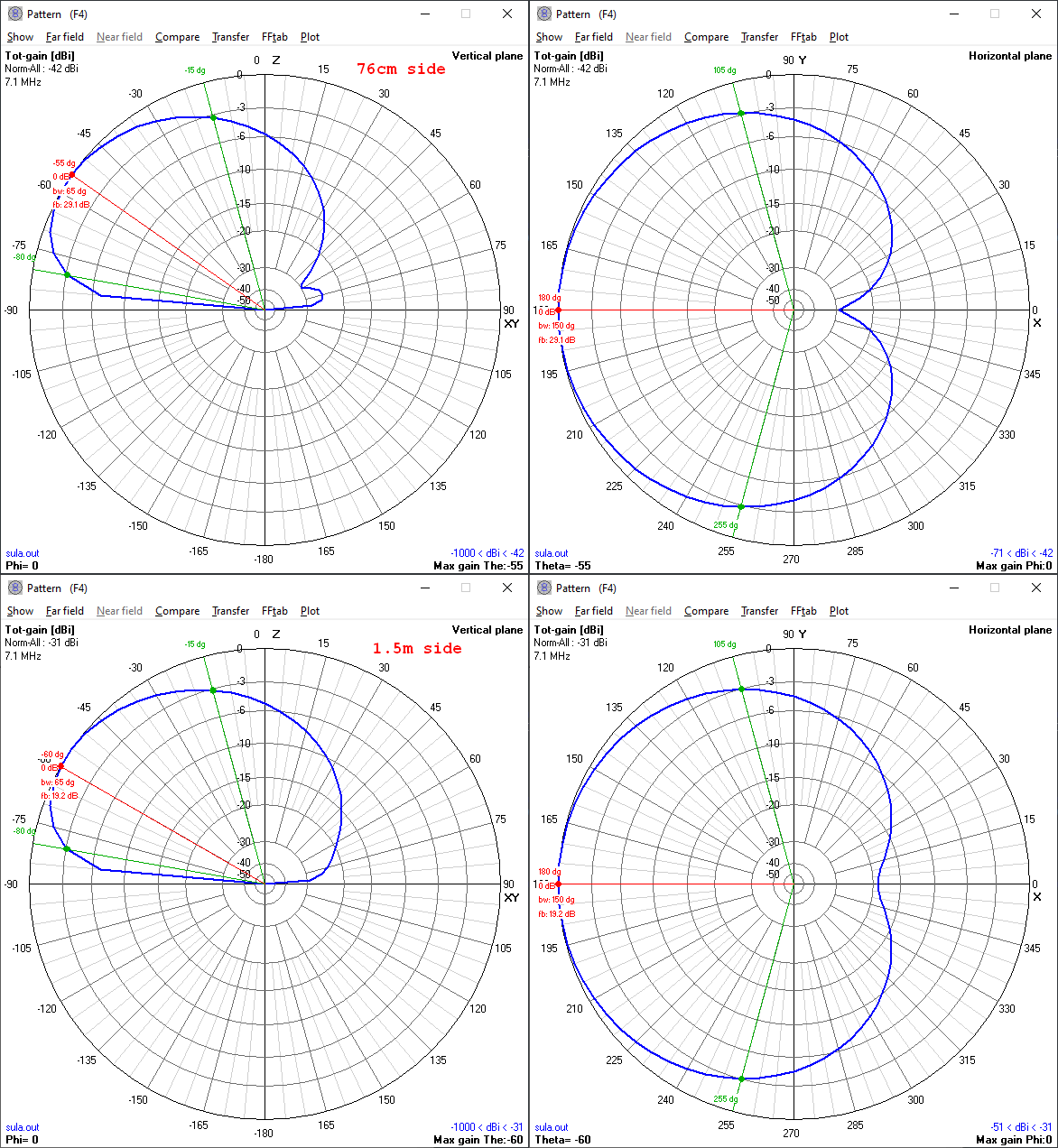
- sula_siz.png (186.97 KiB) Viewed 37508 times
the above shows the standard (76cm side) SULA pattern and the pattern we obtain by raising the side to 1.5m, while the gain changes from -42dBi to -31dBi, the null starts disappearing, also, if we then try moving from 7MHz to (say) 28MHz the effect of the longer side (larger loop) will be the following
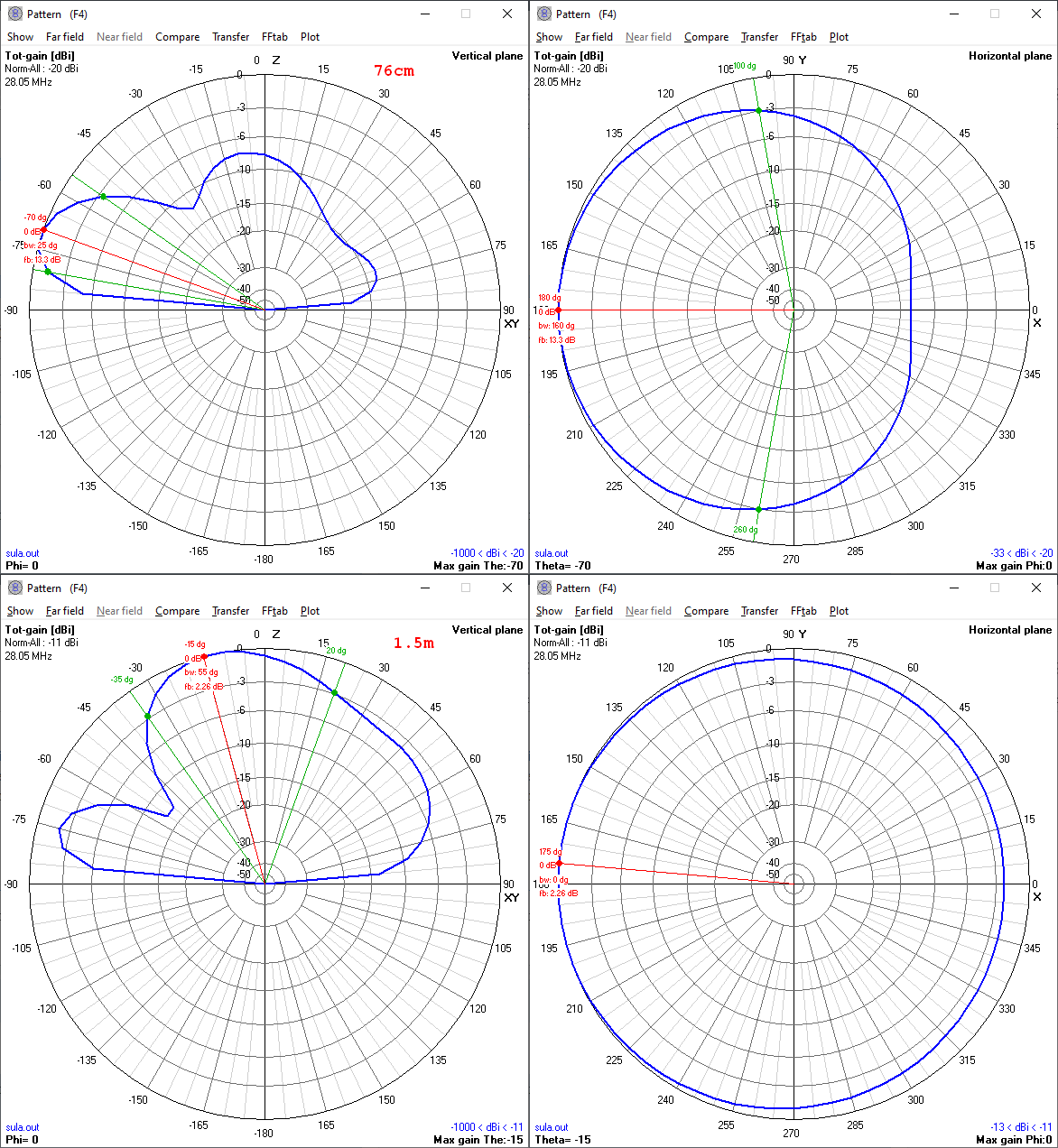
- sula_10m.png (190.91 KiB) Viewed 37508 times
now, if one is only interested in the lower frequencies (say 7MHz and below), increasing the loop size may offer better gain, but if one is seeking for an "all rounder" receive antenna, which is small enough to be easily carried around or used even in case of restrictions (HOA and the like) and which doesn't need to be mounted high, then I believe that the current SULA design should fit pretty well, then for sure it may be possible to further optimize and improve it, but as is now it isn't bad, I think

and, just as a note, here's the pattern of the SULA at 430MHz
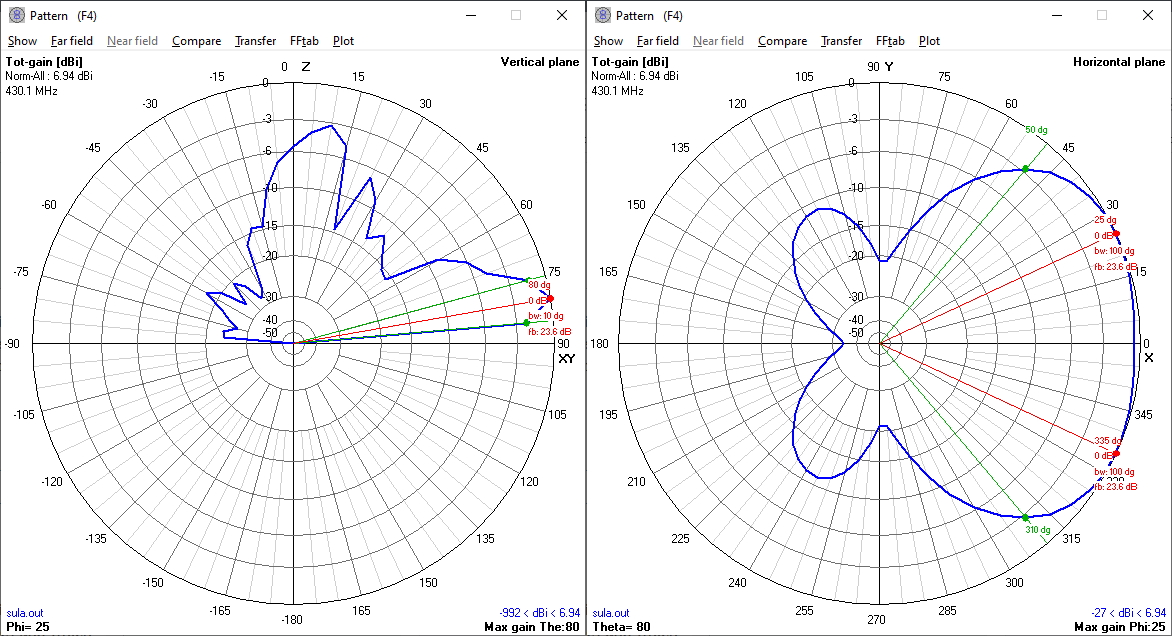
- sula_uhf.png (95.83 KiB) Viewed 37508 times
as you can see, the lobe is reversed, that is points toward the resistor, but the takeoff angle and unidirectional lobe are pretty good, plus at those frequencies the antenna shows positive gain, so one may just omit the preamp

My suggestion, if you can/want, is to try the SULA design "as is", since you have some binocular cores, you may wind your own transformer (but if you want the full coverage, you'll need a transformer capable of working up, to at least 30MHz) and, if you want, you may replace the preamp with a different one but try keeping the antenna design as close as the "standard" one as possible, at least for a start
The above being said, if you'll need further informations or want to further discuss the topic we're here and interested in discussing it and possibly finding ideas to improve it, other than that, the NEC model for the antenna is available
here, to use it one just needs to fetch a copy of the
free 4NEC2 modeler, load the model and then play with the parameters as desired and if you feel versed, I invite you to try !
[edit]
forgot, as for performance on MW, we already tried a number of changes to improve the SULA performance "down" there, but aside from making it VERY larger, increasing its side has little effect and then, by the way, it will totally alter the pattern at higher frequencies so, while performance at LW/MW may be improved, the SULA would become just another "low frequencies loop" while, as it is now, it's a "general coverage" directional antenna which, I believe, may be better than "just another LF loop", also, I think that some people will miss this and just think at the SULA as a "just another 160m antenna" ... but it isn't that kind of thing, as it demonstrated

